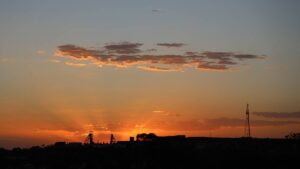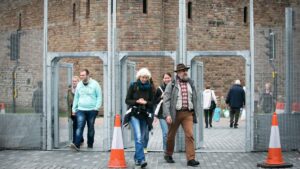These juniors show why the Lachlan Fold Belt remains one of Australia’s most exciting mineral provinces

Pic: SeventyFour/iStock via Getty Images
- Home to over 105Moz of gold and millions of tonnes of copper, the Lachlan Fold Belt doesn’t command the column inches like it should these days
- Godolphin Resources MD Jeneta Owens says the rocks in the New South Wales mineral province make it one of the best places in the world for a company to explore
- We bring you seven juniors looking to make it rain with discoveries in the LFB
The early gold rushes of New South Wales brought almost 370,000 immigrants to Australia in the year after the glint of the precious metal was found near Bathurst in February 1851.
They were soon overshadowed by far more spectacular discoveries in Victoria and eventually Western Australia.
But a renewed sense of adventure from exploration companies, new technology and a new way of looking at the complex geology of the Lachlan Fold Belt, home to over 105Moz of discovered gold, has seen a rush of explorers back into the State.
New South Wales may not have had the reputation for mining prowess of its western counterpart, aside from its dominant and controversial Hunter Valley thermal coal industry.
But it is home to major gold and copper mines like Cadia-Ridgway – commonly one of Australia’s three largest gold producers alongside Boddington and the Kalgoorlie Super Pit – Northparkes and Cobar.
And with major discoveries like Alkane Resources’ 10.1Moz gold equivalent Boda (2019) and a renewed sense of purpose from the NSW Government around fostering its mineral extraction industry – approving both Regis Resources’ McPhillamy’s gold mine and Silver Mines’ (ASX:SVL) Bowdens Silver project in a matter of weeks earlier this year – a new group of explorers is piling into the region.
March quarter exploration figures from the Australian Bureau of Statistics show $77 million was spent drilling in New South Wales in the first three months of 2023, without any data for coal, lithium or rare earths. That’s the third straight year in excess of $75m.
2022 saw a record $351.2m spent exploring for metals in the State, more than $100m more than the $247.4m ploughed into the ground just four years earlier in 2018.
Copper drilling hit an all-time March high of $20.8m as well, illuminating an important point. The Lachlan Fold Belt is not just a locale for gold rushes of the past, but a crucible for the energy transition metals that will propel the future.
It’s the rocks, stupid
So what is it that makes the Lachlan Fold Belt so special?
And why was it that a geological domain first pilfered by prospectors in 1851 took 140 years to deliver a discovery of the world-class scale and gravity of Cadia-Ridgway?
A renowned geologist, Jeneta Owens led the exploration team at China Molybdenum’s Northparkes copper and gold mine but since mid-2021 has been based in Orange as the managing director of Godolphin Resources (ASX:GRL).
Owner of the McPhillamy’s style Lewis Ponds gold deposit, Godolphin owns more than five projects and JV stakes in the region and recently announced a maiden resource at Narraburra, the region’s first standalone ionic clay rare earths deposit.
She says the deep and hidden nature of the prospects in the Lachlan Fold Belt compared to locales with older rock formations like the Eastern Goldfields were a big reason the region remains underexplored.
“So the Eastern Goldfields are completely different kind of rock package,” she told Stockhead.
“The Macquarie Arc targets are probably a bit deeper. They’re also lower grade, so they’re very large scale mineral deposits.
“You normally have high tonnage deposits and I guess the age of them is a bit different as well because in geological settings around the world porphyry style mineralisation is known in younger sediments, younger volcanic rocks like in South America.
“The age of the rocks here and to have it still preserve that old volcanism is quite unique.”
Porphyry puzzle
Porphyry is a key word here. The vast majority of the world’s largest copper mines are bulk, low grade porphyries endowed with by-products like gold, silver and molybdenum.
These are either mined in large open pits or, like the 700,000-800,000ozpa Cadia mine, as underground block caves.
Delivering economies of scale, a block cave is mined by digging caverns beneath the mineralised ore and allowing the mass to collapse under its own weight, enabling huge portions of rock to be moved compared to the stoping method used in narrow-veined orebodies.
Another feature of discoveries in the Lachlan Fold Belt is the first resource is almost always the beginning, not the end. A mine like Northparkes, Owens notes, contains almost 1Bt of copper rich ore across a swathe of different, nearby deposits.
“That’s what’s unique about these types of deposits in the Lachlan Fold Belt, these porphyry styles,” Owens said.
“All of the major mines are not just one individual mine, they are a group of smaller operations or smaller deposits that are clustered together, so that clustering is very important to be able to provide those large tonnages.”
Despite its obvious fertility, most holes drilled across the expanse of the Macquarie Arc have never ventured below 150m deep.
“The area is still well endowed with minerals and there are new discoveries that can still be made,” Owens said.
“There was a period of time when people (thought) that everything that could be found had been found. And even working in the area, you sometimes can think that, but it’s still a place where you can walk across the ground and find copper mineralisation outcropping at surface.
“You can pick up rocks with visible gold, that’s quite rare. It’s not the normal kind of geological environment.”
Modern exploration technology is also helping companies like Godolphin make new discoveries and find new types of deposits within the Lachlan Fold Belt.
“It really does show that even after all this time of people exploring from the 1970s onwards, that new discoveries can be found, and it really is by peeling back the layers,” she said.
“There’s been a lot of research and development going into understanding the geological signatures of these deposits, advancements in geochemistry, advancements in mineral chemistry, things like hylogger capturing the spectral properties of rocks.
“That wasn’t available back in the ’70s and ’80s. And now geophysics has come a long way.
“And, you know, all of these things have led to a greater understanding of what the systems looks like and their large alteration systems, being able to hone in and discover.
“There’s obviously still more out there.”
World’s biggest companies muscling in
Rich in copper and now rare earths in the form of Godolphin’s Narraburra, the LFB is emerging as a key part of the world for supplying the commodities needed for renewables and electric vehicles, technology central to the global green energy transition.
The big buzz around the Lachlan Fold belt recently has also come from the development approvals at McPhillamy’s and Bowdens, as well as Newcrest’s takeover by US gold giant Newmont.
The biggest prize there was, clearly, Cadia.
Boasting at least a two-decade mine life and the potential to become a more than 100,000tpa copper producer alongside its gold bounty, the mine was not yet discovered when Newmont initially merged its Australian gold division with BHP’s and left Newcrest to fend for itself.
“It really does show that around the world these large companies aee the Lachlan Fold Belt as a place to be,” Owens said.
I want to speak to Lachlan, how do I reach him?
There are any number of established names to inspect when headed into the Lachlan Fold Belt.
Newcrest will be off the table soon. But Regis Resources (ASX:RRL) looks like a genuine shot at getting its McPhillamy’s mine off the ground and Bill Beament and Nev Power endorsed Metals Acquisition Corp has bought the 50,000tpa CSA mine in Cobar off Glencore with an Aussie IPO imminent.
Also producing in the region are companies like Aeris Resources (ASX:AIS), Aurelia Metals (ASX:AMI) and Alkane Resources (ASX:ALK), while Australian Strategic Materials demonstrates the versatility of the district.
It plans to develop the Dubbo zirconium and rare earths project and process the resulting metals into products like rare earth magnets at a plant in Korea.
But established, large and mid-cap players aren’t the exciting side of the market.
As Lion Selection Group’s (ASX:LSX) Hedley Widdup pointed out a couple of years ago, one of the reasons the Lachlan Fold Belt is such an exciting place for investors is that your money can go a lot further than spreading it across a market like WA.
“If you generate $15m worth of buying interest (in the Lachlan) it is spread across four or five stories as opposed to someone finding gold in Western Australia (where) the money spreads a lot more thinly,” he told Stockhead at the time.
We’ve combed over the prospects to identify seven exciting juniors kicking the tyres in the Lachlan Fold Belt who could strike it lucky in the LFB.
Godolphin Resources (ASX:GRL)
Spun out of Ardea Resources (ASX:ARL) in 2021, Godolphin’s initial focus was on a host of assets exploring for gold and copper in the Lachlan Fold Belt.
But it has recently shifted focus, making the Narraburra ionic clay rare earths deposit its primary asset with a resource upgrade in April that signposted the deposit as one of national and international significance.
Located 12km northwest of Temora in central west NSW, previous owners at Narraburra had outlined a JORC 2004 compliant mineral resource estimate.
But the new resource compiled by GRL bolstered its tonnage by 30% to 94.9Mt at 739ppm total rare earth oxides, with 50% of the resource indicated and 20Mt at 1079ppm TREO within the indicated resource above a 600ppm cutoff.
On top of that the 739ppm TREO reading represented a 126% increase in grade. ANSTO, Australia’s peak body for nuclear science and technology, has been undertaking work to characterise the mineralisation at Narrabura.
Test work to better understand its composition and processing pathways is expected to start in the next quarter leading into the start of scoping studies before the end of the year.
Initial met testing has been promising, with “exceptional recoveries” of around 94% neodymium and 90% praseodymium, the light rare earth elements associated with the magnets in EV motors and wind turbines.
Godolphin Resources share price today:
Sultan Resources (ASX:SLZ)
Also exploring for gold and base metals in WA and lithium in Canada, Sultan picked up a 330km2 land holding in March 2020 in Australia’s premier gold and copper district.
That of course is the LFB, with the priority Big Hill copper and gold porphyry prospect located in the Molong Volcanic Belt in the same host rocks as Alkane’s Boda discovery 50km to the north and Cadia some 50km to the south.
The acquisition of privately owned Colossus Metals delivered Sultan what was, at the time, the last privately held tenure on the porphyry belt from Boda to Cadia in the Macquarie Arc.
Big Hill, a 5 x 2.5km magnetic high complex on the 108km2 “Star Plateau exploration licence” has been the main target for Sultan, with no prior drilling despite historic workings with outcropping secondary copper mineralisation.
Diamond drilling in 2021 was not able to hit the mother lode at Big Hill and Razorback, but was successful in identifying sulphide minerals consistent with surface mapping and sampling along with elevated levels of gold, silver, copper, arsenic, antimony, molybdenum and tungsten, confirming its potential to host a porphyry copper-gold discovery.
Sultan is currently reviewing its LFB ground to define the next round of exploration and drill targets across its Tucklan, Star Plateau and Ophir tenements.
Sultan Resources (ASX:SLZ) share price today:
Krakatoa Resources (ASX:KTA)
Krakatoa has seen a good deal of success drilling for rare earths at its Mt Clere project in Western Australia.
But the $10 million capped explorer also has not one but three prospective projects in the Lachlan Fold Belt, where it is searching for copper, gold and rare earths in the middle of elephant country.
KTA boast the Belgravia copper-gold porphyry project where it acquired a 100% interest in 80km2 of ground 7km east of Molong and 20km northwest of Orange including the Bell Valley target northeast of the 310,000t Copper Hill deposit.
50km east KTA holds the 120km2 Turon project, near large landholdings pegged by Alkane and one of the world’s largest copper miners Freeport McMoran, and site of significant alluvial and hard rock gold mining in the 19th Century.
Perhaps most interesting is the Rand gold project, over 580km2 in the Central Lachlan Fold Belt, which boasts the Bulgandry Goldfields, where several mines produced gold at grades ranging as high as 265g/t in two mining booms from 1894-1896 and 1932 to 1935.
But recent aircore drilling has found a swag of high grade magnetic and critical rare earth oxides from the surface at the Ryan and Jindera granites.
Grades ranged as high as 8m at 1056ppm TREO and 4m at 1209ppm TREO in near surface hits announced to the market on May 8.
“Our Rand project continues to deliver significant outcomes for the company and these assay results from first pass, wide-spaced AC drilling are highly encouraging and proved that these selective granite types have the potential to host shallow clay REE deposits,” KTA CEO Mark Major said.
“In addition to these encouraging results, the Ryan and Jindera Granites have sizeable footprints that we look forward to investigating further.
“Although our focus remains on our Mt Clere project in Western Australia, our NSW portfolio continues to demonstrate excellent potential for major discoveries.”
Krakatoa Resources (ASX:KTA) share price today:
Kali Metals
The Lachlan Fold Belt is best known for its copper, gold and silver production.
But it has also become a focus of lithium explorers, with juniors hoping to repeat the success of their west coast counterparts in WA.
Two of those projects have been sitting in the portfolio of Kalamazoo Resources (ASX:KZR), the Jingellic and Tallangatta.
Both will be turned out into a new lithium IPO called Kali Metals along with KZR’s DOM’s Hill and Marble Bar projects in the Pilbara and the lithium rights at Karora Resources’ Higginsville tenement package in WA.
KZR will own 55% of the entity which will both Graeme Sloan as MD and Luke Reinehr as chairman ahead of its $10-12m September IPO.
The LFB projects, located either side of the NSW-Victorian border cover over 2000km2 of geology prospective for lithium-caesium-tantalum and tin pegmatite mineralisation.
Kalamazoo Resources (ASX:KZR) share price today:
Golden Deeps (ASX:GED)
Flying under the radar, $4.2 million capped Golden Deeps says it has identified large scale copper-gold porphyry potential in its Havilah project in NSW, where fieldwork has identified three impressive anomalies with high grade copper samples at surface within the Hazelbrook anomaly.
They include results of up to 1.2% copper in chalcopyrite (copper enriched iron sulphide) at the Milfor anomaly.
Results from sampling at Hazelbrook and Hazelbrook North have outlined copper, gold and zinc anomalies over a large 1km by 400m and 400m by 200m footprint respectively.
Golden Deeps is planning drilling at Havilah on targets it says are analogous to Cadia-Ridgway and Northparkes, both hosted in Ordovician volcanics and related intrusives in parallel volcanic arcs of the LFB to GED’s west.
“We have identified an exciting new porphyry copper-gold prospect on our Havilah Project in the world-class Lachlan Fold Belt copper-gold province of central NSW,“ Golden Deeps CEO Jon Dugdale said in March.
“The Hazelbrook Prospect has a similar footprint to other major deposits in the LFB, such as the Cadia-Ridgeway deposits, and we are very much looking forward to drill testing these exciting new target zones.”
Golden Deeps (ASX:GED) share price today:
Polymetals Resources (ASX:POL)
In a market characterised by tough conditions for microcaps, Polymetals is up an eye-catching 34% in 2023 and over 200% in the past 12 months.
Behind it all is the progress of its exploration at the Endeavour Mine in New South Wales’ Cobar Basin, where drilling hit silver values of up to 1535g/t Ag at the Endeavour South Lode in April.
The mine was discovered in 1974 and run from 1982, producing 32.3Mt at 8.01% zinc, 5.04% lead and 89.2g/t silver until its former owner, a subsidiary of Japan’s Toho Zinc, placed it in mothballs at the end of 2019.
Its not the first time POL chairman David Spoule has come across Endeavour. His previous private company, Polymetals Australia, bought stockpiled supergene tailings from the owner Pasminco in 1992 to treat it for silver and gold.
The South Lode was shut by a literal accident of history. An uncontrolled cave-in resulted in the vertical displacement of the lode’s remaining resources.
But Polymetals says a quantity of the high grade South Lode resources remain intact. Meanwhile, it has increased the silver inventory of the near surface resource in the Upper Main Lodes of the mine by 2.9Moz to 8.9Moz, with 94% in the measured and indicated category.
POL says it obtained the asset for just 7% of the $150m independent valuation of the mine, with a revision of an onerous 100% silver streaming royalty to a 4% silver-zinc-lead net smelter royalty opening the door to restart it.
Polymetals Resources (ASX:POL) share price today:
Peel Mining (ASX:PEX)
Peel has been quietly going about its business this year while it works through a pre-feasibility study for it South Cobar project and undertakes permitting to develop underground exploration declines for the Mallee Bull, Wirlong and Southern Nights-Wagga Tank deposits.
That will be based off one of the larger high grade resources delineated in the Cobar region, host to a catalogue of similar copper mines.
That includes 20M of ore containing 216,000t copper, 322,000t zinc, 151,000t lead, 22Moz silver and 204,000oz gold, with around 70% of the resource and 77% of the copper in the higher confidence indicated category.
$67 million capped Peel had $13.6m in the bank as of March 31.
Peel Mining (ASX:PEX) share price today:
At Stockhead, we tell it like it is. While Godolphin Resources and Sultan Resources are Stockhead advertisers, they did not sponsor this article.
Related Topics

UNLOCK INSIGHTS
Discover the untold stories of emerging ASX stocks.
Daily news and expert analysis, it's free to subscribe.
By proceeding, you confirm you understand that we handle personal information in accordance with our Privacy Policy.








